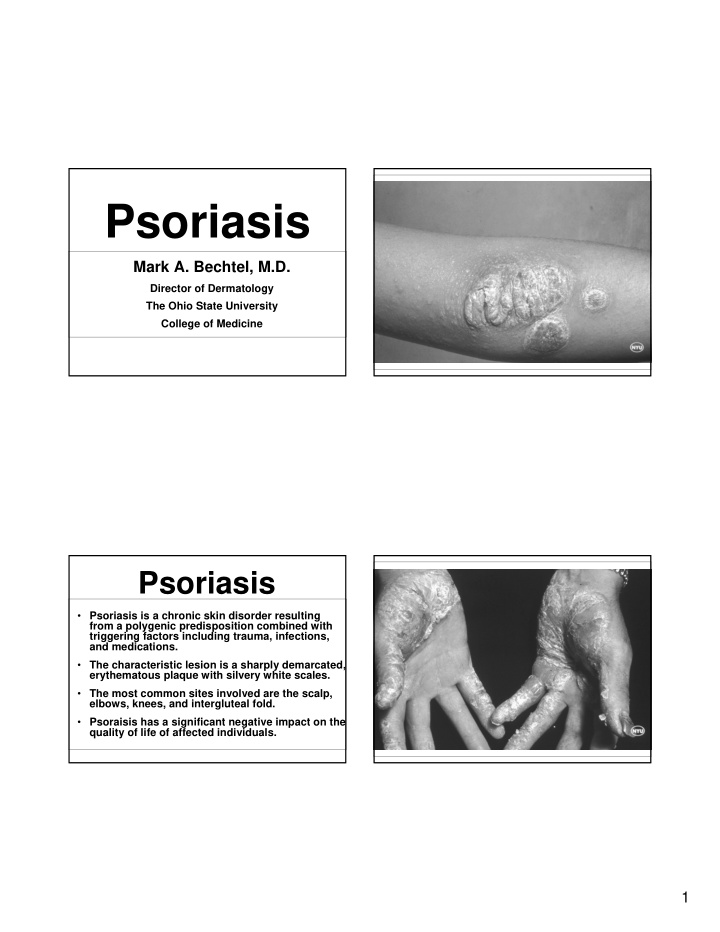



Psoriasis Mark A. Bechtel, M.D. Director of Dermatology The Ohio State University College of Medicine Psoriasis • Psoriasis is a chronic skin disorder resulting from a polygenic predisposition combined with triggering factors including trauma, infections, and medications. • The characteristic lesion is a sharply demarcated, erythematous plaque with silvery white scales. • The most common sites involved are the scalp, elbows, knees, and intergluteal fold. • Psoraisis has a significant negative impact on the quality of life of affected individuals. 1
Psoriasis - Immunology • An immune mediated disorder • Predominant TH 1 cytokine profile • Memory effector T-cells (CD45RO+) play a major role • TNF-alpha is important in psoriatic arthritis and cutaneous psoriasis Psoriasis-Epidemiology Triggering Factors and Genetics • Koebner phenomenon – injury to the • Psoriasis involves 2% of the world’s population. skin, sunburn • In the U.S., the prevalence may be as high as 4.6%. • Infections – especially streptococcal infections, HIV, hepatitis C • It is estimated that 4.5 million Americans suffer from psoriasis. • Psychogenic stress • Approximately 1.5 million Americans have • Medications – lithium, interferon, B- moderate to severe psoriasis. blockers, antimalarials, rapid tapers of • Psoriatic arthritis occurs in 5-30% of patients, corticosteroids depending on diagnostic criteria utilized. 2
Psoriatic Arthritis – Clinical Patterns • Distal interphalangeal joints of hands and feet • Oligoarthritis – asymmetrical, 4 or fewer joints • Polyarthritis – symmetrical, similar to RA, > 5 joints • Arthritis mutilans • Spondyloarthropathy Psoriasis - Associated Medical Conditions • Patients have an increased risk of lymphoma • Psoriasis may confer an independent risk of myocardial infarction with the greatest risk in young patients with severe psoriasis. • Increased incidence of obesity • Increased incidence of depression • Increased incidence of metabolic syndrome 3
Psoriatic Arthritis • Patients complain of morning stiffness, usually > 45 minutes in duration. • Enthesitis – inflammation at tendon insertion into bone • Dactylitis – inflammation and swelling of a whole digit • Nail involvement in > 80% of patients • HLA-B-27 positive in > 80% • Some anemia, leukopenia, thombocytopenia Chronic Plaque Psoriasis • The most common variant of psoriasis • Symmetric distribution of sharply defined, erythematous, scaling plaques • The scalp, elbows, knees, presacrum, hands, and feet are sites of predilection 4
Erythrodermic Guttate Psoriasis Psoriasis • A common presentation in children • Characterized by generalized erythema • Often preceded by strep pharyngitis or and scaling severe upper respiratory infection • > 50% of patients have elevated ASO, anti- • Onset may be acute or gradual DNase B, or streptozyme titers • Need to rule out atopic dermatitis, T-cell • Presents as multiple widespread discrete lymphoma, and pityriasis rubra pilaris papules and plaques with white scales Pustular Variants • Von Zumbusch pattern – generalized pustules, fever, leukocytosis • Annular pattern • Pustulosis of palms and soles • Acrodermatitis continua of Hallopeau 5
Treatment - Topical Nail Psoriasis Therapies • Incidence varies from 10-80% • Topical corticosteroids – first line as • Psoriasis affects the nail matrix, nail bed, monotherapy or in combination hyponychia • Vitamin D analogues • May produce nail pits, oil spot sign, leukonychia, subungual hyperkeratosis • Anthralin • Nail involvement is common in psoriatic • Topical retinoids arthritis • Coal tar derivatives 6
Treatment - Methotrexate - Phototherapy Indications • Broadband UVB • Chronic plaque psoriasis (> 20% BSA) • Narrow band UVB (311-313 nm) • Pustular psoriasis • PUVA – photochemotherapy with UVA • Erythrodermic psoriasis • Excimer laser 308 nm • Psoriatic arthritis Methotrexate - Systemic Therapies Contraindications • Methotrexate • Creatinine clearance < 60 ml/min • Trimethoprim-sulfamethoxazole • Cyclosporine • Pregnancy and lactation • Systemic retinoids • Significant liver abnormalities • Severe anemia, leukopenia, thrombocytopenia 7
Cyclosporine - Systemic Retinoids Indications - Indications • Severe psoriasis • Severe psoriasis which cannot be managed by topical therapies or light • Conventional therapies ineffective or therapy inappropriate • Erythrodermic or pustular psoriasis Systemic Retinoids - Cyclosporine - Contraindications Contraindications • Moderate to severe liver disease • Impaired renal function • Severe kidney dysfunction • Uncontrolled hypertension • Pregnancy and lactation • Past or present malignancy • Women of childbearing age who cannot guarantee adequate contraception during therapy • History of excessive light therapy and up to 3 years following discontinuation of therapy • Active infections • Hyperlipidemia 8
Biologic Agents - Biologic Agents – Anti TNF Indications Alpha Targeted Therapy • Patients with moderate to severe • Etanercept – human fusion protein, psoriasis eligible for systemic receptor inhibitor treatment • Infliximab – chimeric monoclonal antibody • Psoriatic arthritis • Adalimumab – human monoclonal antibody Biologic Agents - Biologic Agents – Contraindications Inhibit T-cells • Active tuberculosis • Alefacept – human fusion protein • Significant viral, bacterial, or fungal infections targets CD2 • Increased risk for developing sepsis • Efalizumab – humanized antibody – • Malignancy within the past 5 years targets CD11a • With anti-TNF agents – autoimmune disease, blood dyscrasias, hepatitis B, congestive heart failure, demyelinization disorders 9
Recommend
More recommend